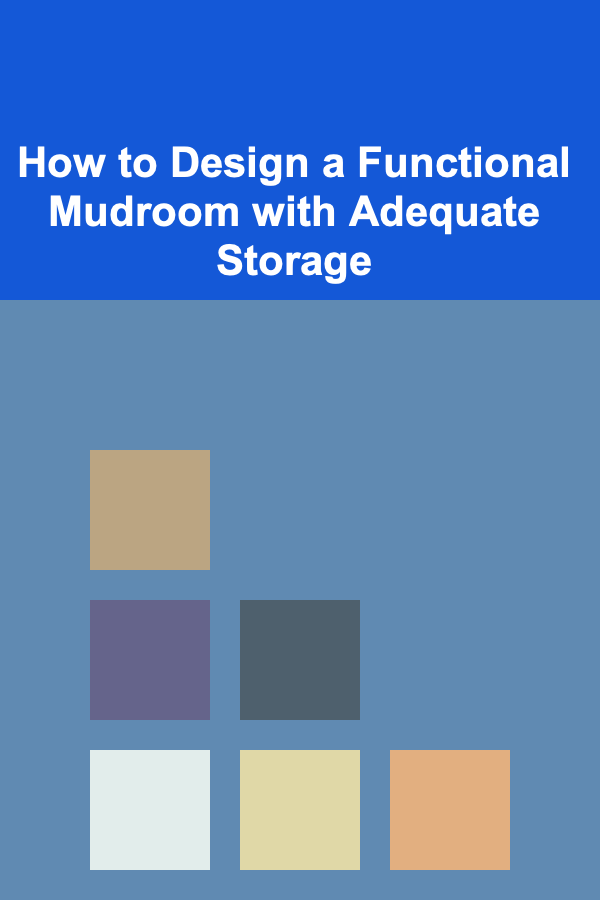
How to Design a Functional Mudroom with Adequate Storage
ebook include PDF & Audio bundle (Micro Guide)
$12.99$7.99
Limited Time Offer! Order within the next:

A mudroom is an essential part of many homes, providing a dedicated space for transitioning from the outside world to the comfort of your home. It acts as a buffer between the mess and dirt of outdoor activities and the cleanliness of the indoor environment. Whether it's a small nook or a large, sprawling area, designing a mudroom with adequate storage is crucial for keeping your home organized, functional, and welcoming.
In this article, we'll dive deep into the process of designing a functional mudroom with adequate storage. We'll explore the components you need, how to optimize space, different organizational systems, and creative design ideas to help you make the most of this often-overlooked part of your home.
Understanding the Function of a Mudroom
Before diving into the design aspects, it's important to understand the core function of a mudroom. A mudroom serves as the transition space between the outdoors and indoors, often acting as a place to:
- Store outerwear: Coats, jackets, boots, and shoes that are worn when outdoors.
- Manage wet or dirty gear: For those who live in colder climates or are active outdoors, muddy boots, snow gear, sports equipment, and raincoats are common items found in a mudroom.
- Organize small accessories: Items like hats, gloves, scarves, bags, umbrellas, and keys often accumulate in the mudroom.
- Provide space for cleaning: Sometimes, a mudroom also functions as a laundry area where dirty clothes are changed out of before entering the main parts of the house.
With these functions in mind, the primary goal of designing a mudroom is to have storage systems that not only accommodate these needs but do so efficiently and conveniently.
Space Planning for a Mudroom
The first step in creating a functional mudroom with adequate storage is to consider the space you're working with. Mudrooms are often located near main entryways or garages, but they can vary in size from tiny alcoves to expansive rooms. How you design your mudroom will depend largely on its dimensions and your family's specific needs.
1. Location Matters
If your mudroom is a small space, such as an entryway off the kitchen, consider using vertical storage options like shelves, hooks, and racks to make the most of the space. Larger mudrooms, often found near garages or back entrances, can be configured with cabinets, seating areas, and more substantial storage solutions.
- Proximity to Outdoor Elements: Ideally, the mudroom should be located near the primary entrance to the house where people typically enter from outside. This is especially important in climates with harsh weather conditions or for homes with a lot of outdoor activity.
- Traffic Flow: Think about how people will use the mudroom. If you have multiple people entering at once, there should be enough space for them to navigate and store their items without congestion. For larger families, consider dedicated spaces for each person's outerwear and gear.
2. Maximizing Storage in Limited Space
For smaller mudrooms, storage is often the challenge. However, there are several ways to maximize the available space:
- Use Vertical Space: When floor space is limited, use the height of the walls for storage. Install tall cabinets, shelves, or hooks that can store coats, bags, and accessories out of the way.
- Overhead Storage: Adding overhead cabinets or shelves above a bench or entryway space can help store less frequently used items like seasonal clothing or extra cleaning supplies.
- Multi-Functional Furniture: Choose furniture pieces that serve more than one purpose. A storage bench can provide seating and hidden storage for shoes, hats, or gloves. Benches with drawers are great for storing boots or shoes, and they can also act as a place to sit while putting on or removing footwear.
3. Design for Ease of Use
A well-designed mudroom should make daily use as seamless as possible. Make sure there's enough space for everyone to store their belongings without hassle. For example:
- Hooks and Pegs: These are excellent for quick access to coats, bags, hats, and scarves. Use a combination of hooks and pegs for different types of gear, and install them at varying heights to accommodate both adults and children.
- Storage Bins and Baskets: Use bins or baskets for loose items like shoes, gloves, or pet leashes. Labeling them can add another layer of organization.
- Seating Area: If your space allows, include a small bench or seating area. It's useful for taking off shoes and boots, especially in a home with kids or during rainy or snowy weather.
Essential Components for a Functional Mudroom
Now that we've established the space planning considerations, let's look at some essential components that every functional mudroom should have for adequate storage.
1. Hooks and Pegs
Hooks and pegs are the workhorses of any mudroom. They provide a simple and easy-to-access solution for hanging coats, hats, bags, umbrellas, and other items you might need when heading out the door. Some considerations for hooks and pegs include:
- Height and Placement: Install hooks and pegs at various heights to accommodate different members of the family, including children. You can set lower hooks for kids and higher ones for adults.
- Durability: Choose hooks made from durable materials like metal or solid wood to ensure they can hold heavy coats, backpacks, or bags.
- Space Between Hooks: Ensure there's enough space between hooks so that coats don't become too crowded and can hang freely.
2. Shoe Storage
Shoes can quickly pile up in a mudroom, especially during wet or muddy weather. Proper shoe storage is key to keeping your mudroom tidy.
- Shoe Racks: A basic shoe rack or shelf can help organize footwear. In larger mudrooms, consider a dedicated shoe storage area with multiple levels or compartments.
- Built-In Cubbies: Cubbies or open shelves allow you to store shoes in an organized manner while keeping them accessible. Cubbies can also be used to store other items like hats, gloves, or backpacks.
- Over-the-Door Shoe Organizers: If you're tight on floor space, consider an over-the-door shoe organizer. These are perfect for storing shoes while keeping the floor clear and maximizing vertical space.
3. Storage Bins and Baskets
Bins and baskets help keep small items contained and organized. From sports equipment to mittens and scarves, having a designated place for everything reduces clutter and ensures that everything has its proper place.
- Stackable Bins: Stackable bins are a great way to save space while keeping things organized. They can be used for items like gloves, scarves, pet supplies, or sports gear.
- Labeling: Labeling bins and baskets makes it easier to identify where things belong and prevents items from getting mixed up.
- Aesthetic Considerations: Opt for bins and baskets that blend well with the overall aesthetic of the mudroom. You can choose from a variety of materials such as wicker, fabric, or plastic to match your style.
4. Seating
Seating in the mudroom is incredibly practical, particularly when it comes to putting on or taking off shoes. A small bench can make this process much easier.
- Built-In Bench: A built-in bench provides not only seating but also extra storage underneath. This space can be used for shoes, boots, or cleaning supplies.
- Ottoman or Folding Bench: For a more flexible solution, consider an ottoman or folding bench that can be tucked away when not in use.
5. Shelving and Cabinets
Shelving and cabinetry can help to further organize a mudroom, keeping larger items or less frequently used belongings out of sight.
- Open Shelving: Open shelving works well for items that need to be easily accessible, such as bags, hats, and backpacks. You can stack these items neatly, or use baskets for additional organization.
- Closed Cabinets: Cabinets with doors are perfect for hiding clutter and storing items like cleaning products, seasonal gear, or other accessories that you don't use regularly.
6. Laundry Area (Optional)
In some homes, a mudroom also doubles as a laundry room or contains a laundry station. If this is the case, adding a washer and dryer, as well as sorting bins or hampers for dirty clothes, is a great way to use the space efficiently.
- Washer and Dryer: Place a compact washer and dryer in a dedicated area within the mudroom. Consider stacking them vertically to save floor space.
- Sorting Bins: Sorting bins for different types of laundry (whites, darks, delicates) can help streamline the laundry process.
Design Ideas for a Mudroom with Adequate Storage
Here are a few creative design ideas that can help you design your mudroom and incorporate adequate storage:
1. Rustic Charm with Open Shelving
For a cozy, rustic feel, opt for reclaimed wood shelves and baskets. The natural wood finish adds warmth to the space, while the open shelving makes it easy to access everything you need quickly.
2. Modern and Sleek with Built-In Storage
If you prefer a sleek, contemporary design, built-in cabinetry with clean lines can provide hidden storage. Choose neutral colors like white, gray, or black, and incorporate stainless steel or matte finishes for a modern touch.
3. Mudroom with a Personal Touch
Add personality to your mudroom by incorporating unique elements such as colorful hooks, patterned wallpaper, or vintage accessories. This will make your mudroom not only functional but also visually appealing.
4. Mudroom for Larger Families
If you have a large family, create designated spaces for each member's gear. Consider using separate lockers or cubbies for each person, complete with hooks for jackets and shelves for shoes. Add personalized touches like name tags or baskets for each individual.
Conclusion
Designing a functional mudroom with adequate storage is an important part of creating an organized and efficient home. The key is to think about your storage needs, use the available space wisely, and choose the right components that suit your lifestyle. Whether you're working with a small nook or a larger space, the right design can make a world of difference in keeping your home tidy and clutter-free.
By incorporating hooks, seating, shoe storage, bins, and shelving, and paying attention to how each piece contributes to the overall flow of the space, you can create a mudroom that serves its functional purpose while also enhancing the aesthetic appeal of your home. With thoughtful planning, your mudroom can be both a practical and inviting space that makes daily life just a little bit easier.
Reading More From Our Other Websites
- [Home Space Saving 101] How to Save Space in Your Home Office with a Compact Desk Setup
- [Home Cleaning 101] How to Clean a Carpet: Effective Methods for Stain Removal and Freshening
- [Home Maintenance 101] How to Upgrade Your Appliances Without Breaking the Bank
- [Rock Climbing Tip 101] Best Strategies for Training Endurance on Long, Low‑Angle Alpine Routes
- [Home Renovating 101] How to Use the Best Tools for Home Renovation to Maximize a Small Bathroom Remodel
- [Personal Financial Planning 101] How to Create a Budget: A Simple Guide to Managing Your Money
- [Tiny Home Living Tip 101] Best Space‑Saving Storage Hacks for Tiny Home Artisans and Crafters
- [Home Cleaning 101] How to Remove Mold and Mildew from Your Home
- [Survival Kit 101] How to Build a DIY Survival Kit for Extreme Cold Weather Hiking Adventures
- [Organization Tip 101] How to Maintain an Inventory of School Supplies for the Year

How to Create a Kid-Friendly Pantry Setup
Read More
How to Start Writing from Home and Turn It into a Full-Time Job
Read More
How to Use Vertical Space for Storage and Organization
Read More
What Tips Can Help You Organize a Shared Living Space?
Read More
How to Practice Forgiveness for Mental Freedom
Read More
How to Understand Customer Psychology for Profit: A Deep Dive into the Mind of the Consumer
Read MoreOther Products

How to Create a Kid-Friendly Pantry Setup
Read More
How to Start Writing from Home and Turn It into a Full-Time Job
Read More
How to Use Vertical Space for Storage and Organization
Read More
What Tips Can Help You Organize a Shared Living Space?
Read More
How to Practice Forgiveness for Mental Freedom
Read More